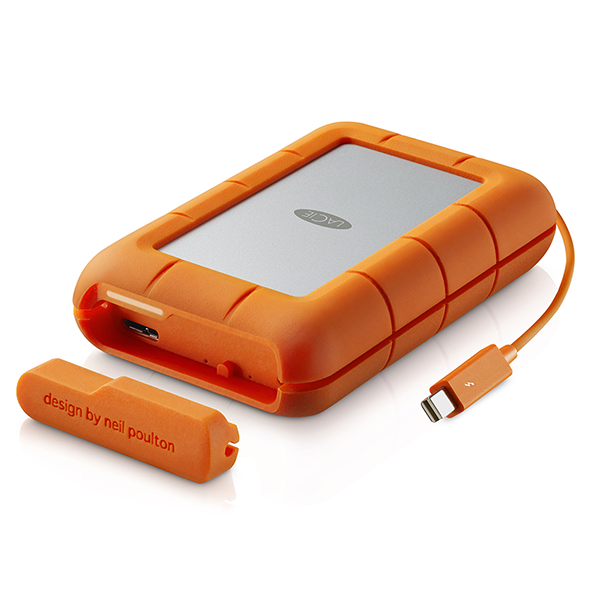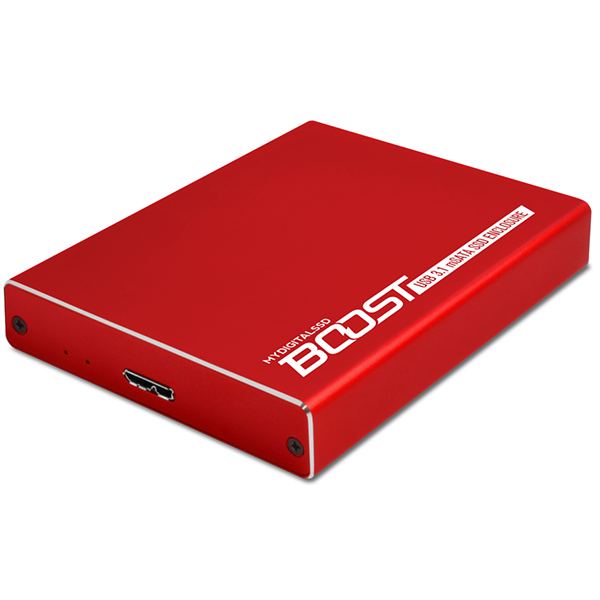Netstor NA611TB3 Thunderbolt 3 NVMe External SSD Review
Why you can trust Tom's Hardware
Benchmarks & Conclusion
Comparison Products
We've tested a number of very fast external storage drives over the last year. The MyDigitalSSD BOOST and SanDisk Extreme 900 battled it out for the fastest USB 3.1 Gen 2 storage, but they can't compete with the Netstor NA611TB3 loaded with a Samsung 960 Pro 1TB NVMe SSD, much less two in RAID 0.
We brought along some other high-speed flash drives for this review. The 2TB Samsung Portable SSD T5 is the successor to the 2TB T3, but we included both in this review. The 512GB Adata SD700 is a previous award winner thanks to its excellent price and solid features.
The only hard disk drive in the review comes from LaCie. The Rugged RAID is the only portable disk-based solution we've tested that can compete with these flash drives. Its performance comes from a pair or HDDs running in RAID 0 that provide enough grunt to run sequential workloads faster than you might think possible.
Block Size Testing
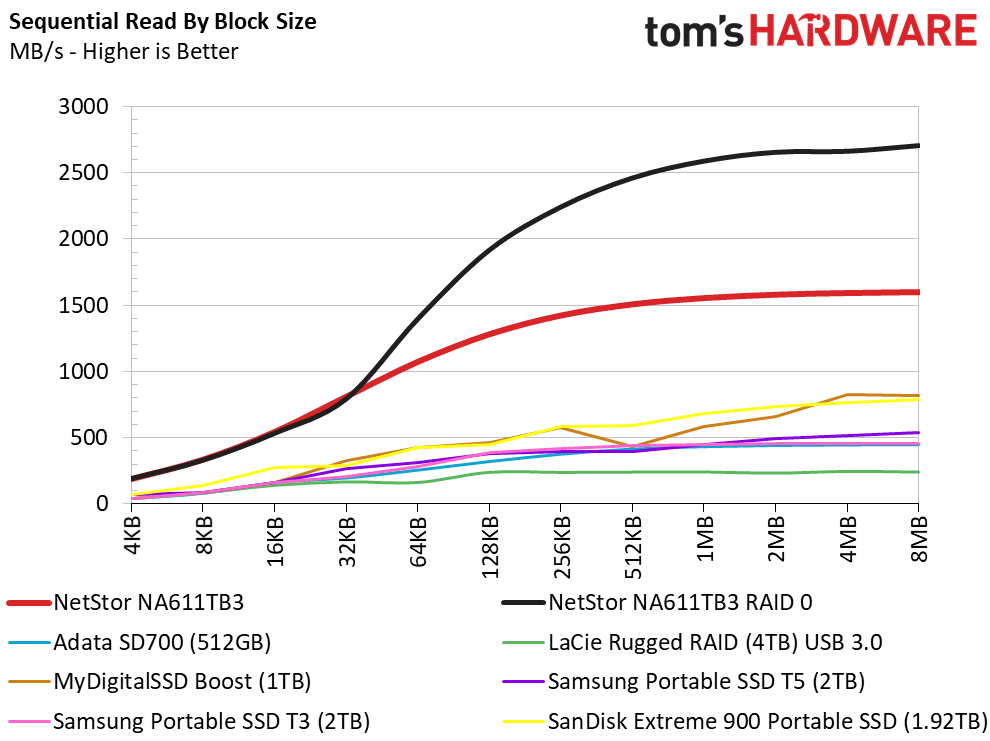
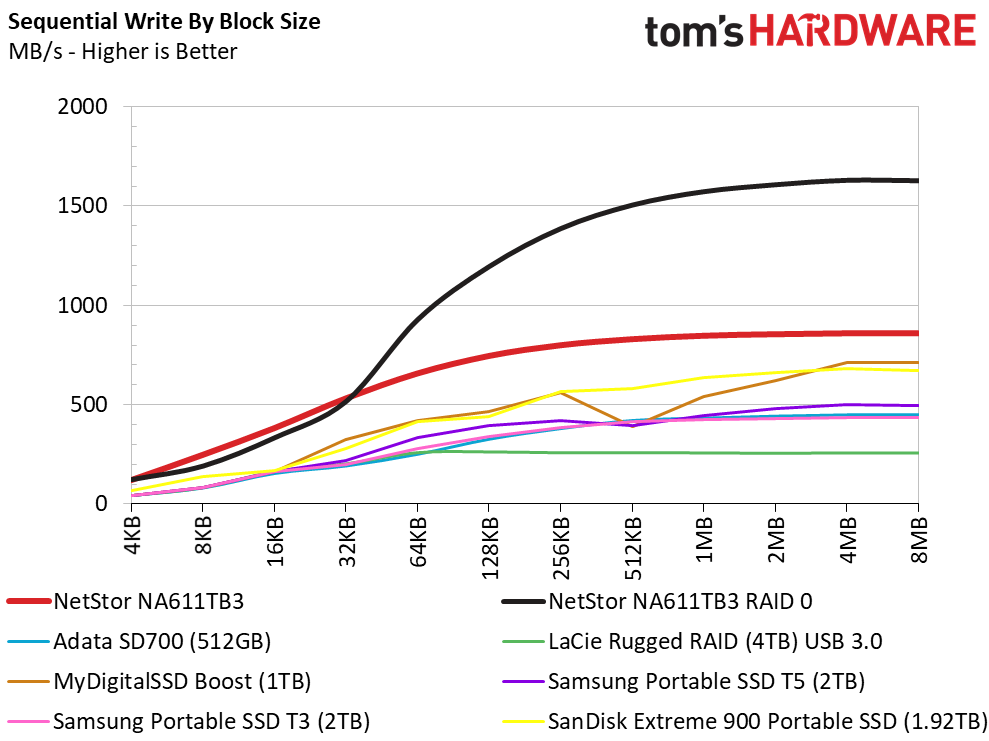
If you like a close fight, this review will get very boring, very quickly. The Netstor NA611TB3 is exceedingly quick. The drive outperforms every other external drive at every single block size, and it doesn't matter if we are reading or writing data. The NVMe protocol was developed to make this an unfair fight, and it works as advertised.
With smaller blocks, the Windows 10 RAID 0 array is a little slower than a single drive. The array picks up speed with larger blocks. The big numbers come with 64KB and 128KB blocks. Those just happen to be the block sizes that make up large audio and video files.
Full LBA Span Performance
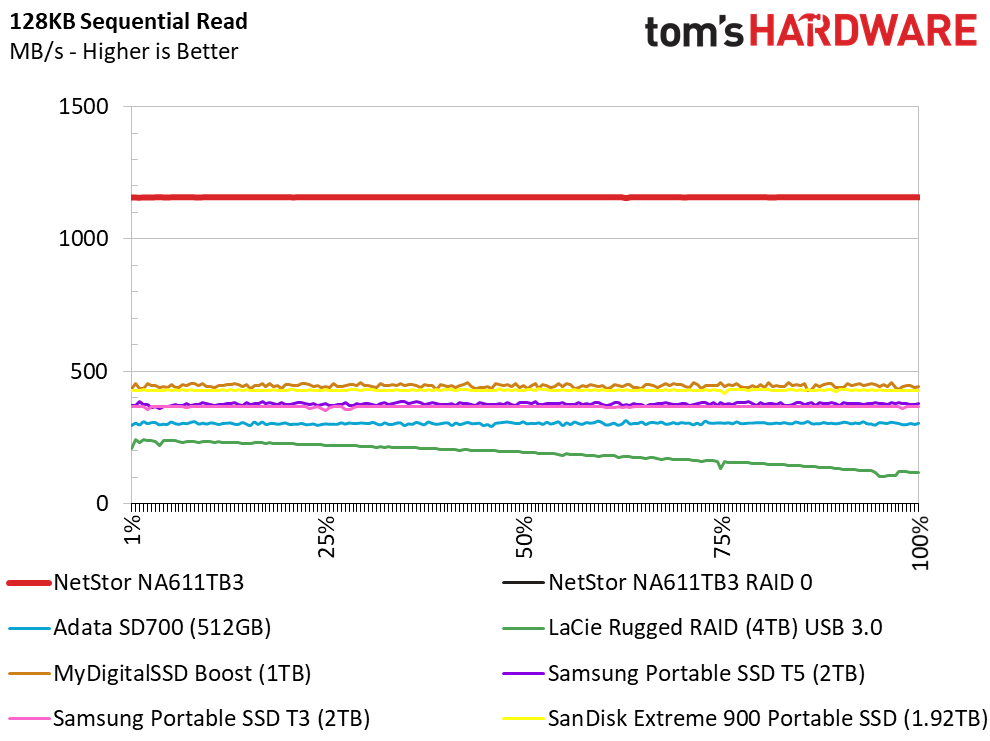
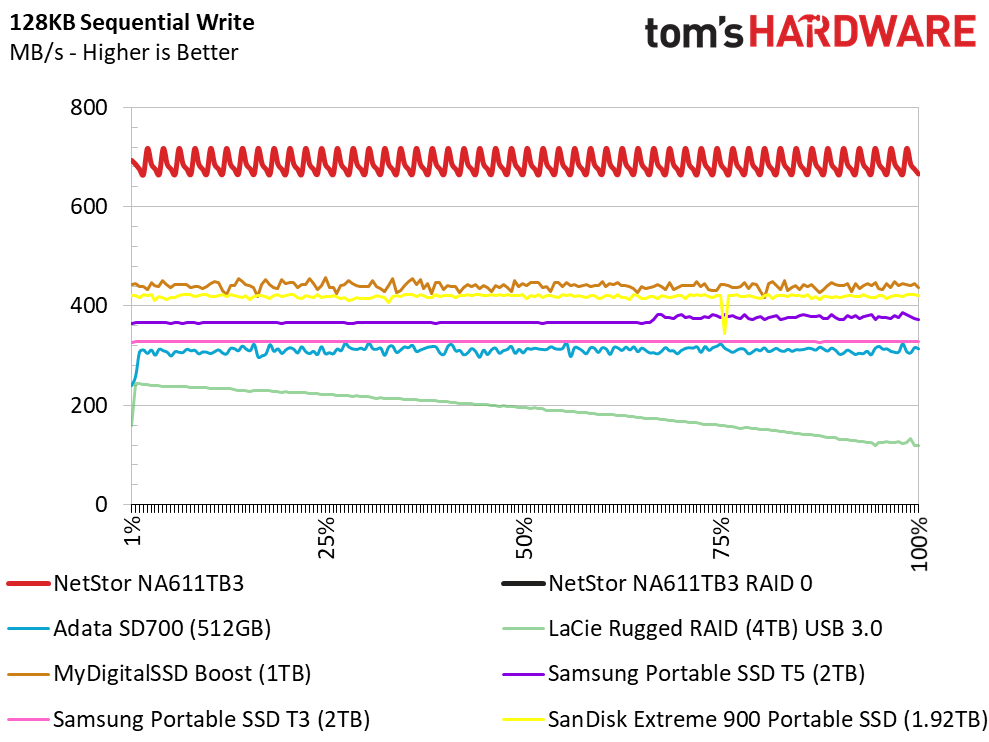
The software we use can't address a Windows 10 RAID array, but we can still test the single-drive QD1 sequential read and write performance. This is the performance you can expect by simply reading or write a single video file to the drives. The LaCie hard disk drive is the only product that suffers performance degradation, but that's due to its patter-based design.
The flash drives are all very consistent, but only one rides so high in the charts that the other lines look like its shadow.
Get Tom's Hardware's best news and in-depth reviews, straight to your inbox.
File Transfers
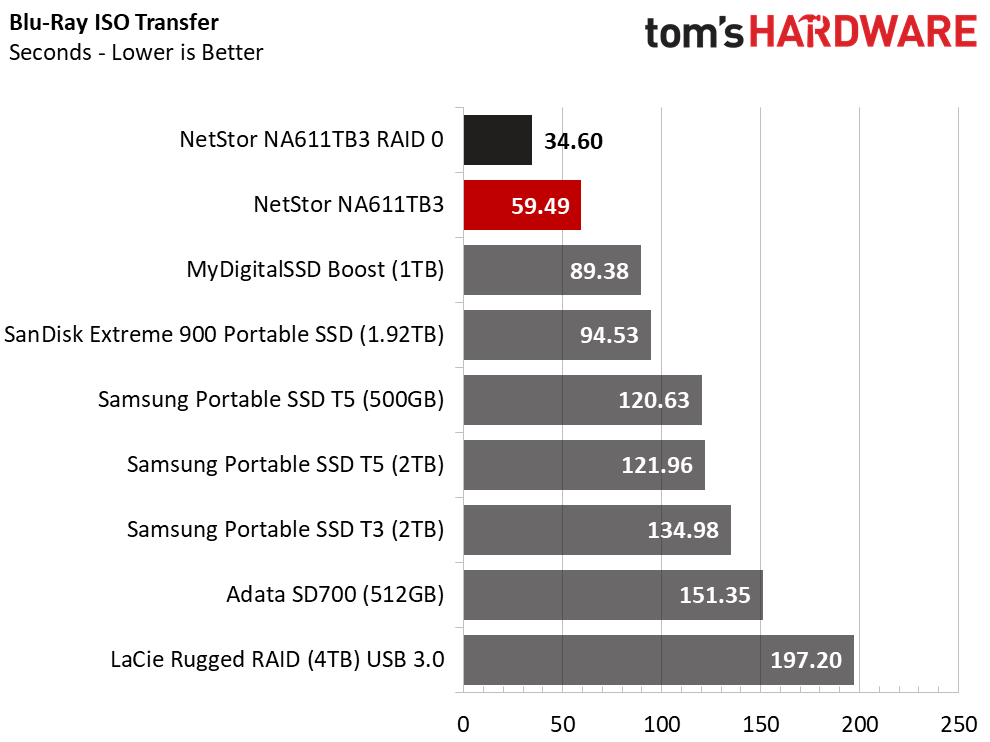
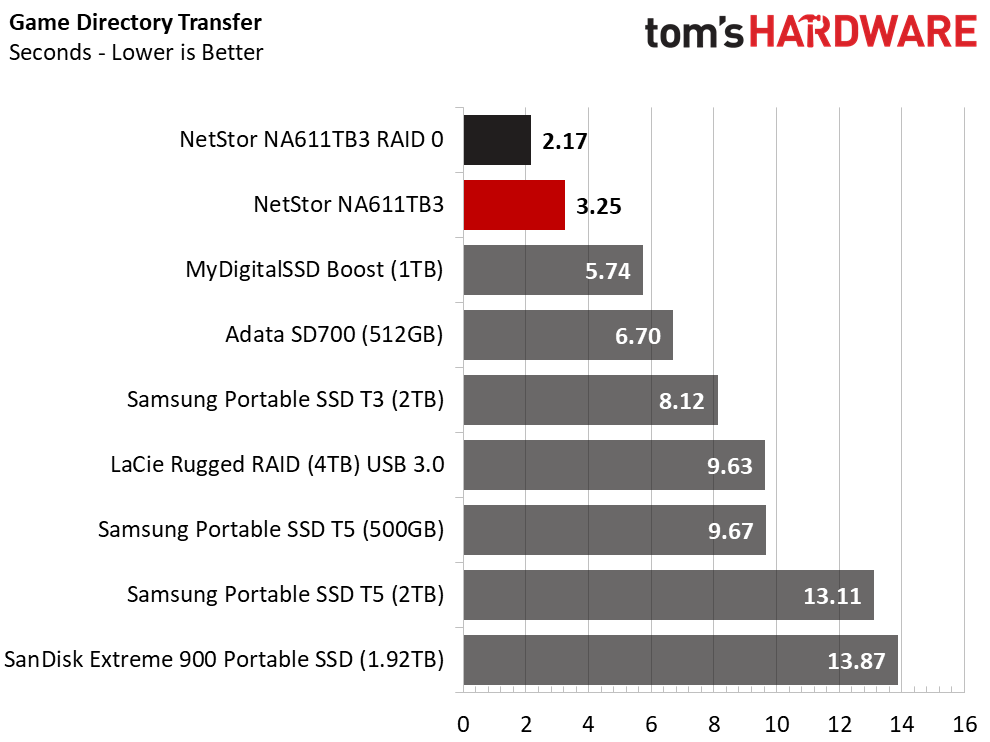
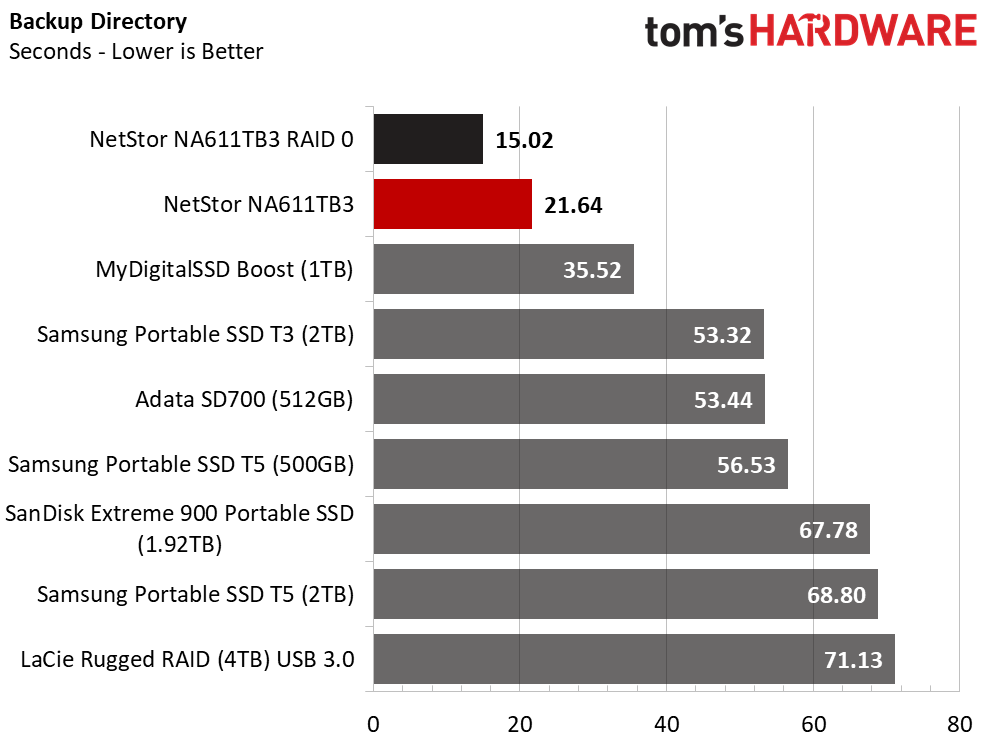
We don't run many application tests on external or portable storage products because the typical workload is sequential in nature. Most of us simply read and write large pieces of data for archiving or transferring data from one location to another.
We often see performance measured in throughput, but time-based results are easier to interpret because the sense of time is universal. We tested transfer performance with a Blu-ray ISO. For the Game test, we used rFactor to transfer data from the post-installation directory to the portable drives. The Directory Test is a 15.2GB block of data that contains a mix of images, software installations, ISO files, and multimedia.
All of that NVMe performance carries over to our real-world transfer tests. The NVMe interface is designed to streamline commands and reduce latency compared to the legacy SATA technology that the other products use. This is what innovation in storage is all about. There is a significant time difference between the Netstor single drive and the MyDigitalSSD BOOST, which is pretty speedy in its own right.
The cost may be significant, but the two-drive array with a pair of 1TB Samsung 960 Pro SSDs boosts the results even more. The array is like having a crystal ball that shows what's possible in the next generation, but there are no witches here. The Netstor can give you that performance today, but there is a high cost to pay for ultimate performance.
Conclusion
The Netstor NA611TB3 has a forgettable name, but its performance is legendary. This is the first product we've tested that takes advantage of NVMe over a high-speed Thunderbolt 3 connection, but we hope to see more of these devices in the future. The NA611TB3 is fun, and the performance is exciting, but the form factor isn't for everyone.
Technically, it's portable. We've seen bulkier products fall into this mobile class, even if we count the additional power brick. That still doesn't make it practical with the extra box that you have to drag around. The power box also requires another cord, and that adds to the overall bulk. This enclosure is better suited for home or office use than it is for traveling between the two.
Professional photographers and videographers will not give the size a second thought considering all the other gear they take into the field. You'll know if the size and additional parts are acceptable for you–we can't make that decision. At least the NA611TB3 doesn't require a Pelican case like the LaCie 12big.
The Netstor's performance is in a class of its own. The NA611TB3 stands alone with a crowd of pretenders that are far behind, similar to what we've seen with NVMe SSDs in desktops and notebooks. The difference is this system was designed for workloads that benefit more from NVMe.
The RAID features are controlled entirely by the operating system. Hardware RAID has all but disappeared. The enterprise market moved to "software-defined" everything, and that hurt performance. Enthusiasts still like hardware acceleration because good enough is for bean counters, not the pedal-to-the-metal crazies that spend obscene amounts of money to push the limits.
This product uses a unique electrical configuration that works well. On paper, and even during our preparation, we were worried about the PCI Express 3.0 x2 configuration. We came away pleasantly surprised with the final results.
You will pay more for this level of performance. The Netstor NA611TB3 will set you back $339.99, and you still have to buy two NVMe SSDs. NVMe SSDs start out slightly below $100, but you want MLC NAND for 4K video production, and lots of it. The 1TB Samsung 960 Pro drives we used cost more than $600 each. If you want maximum capacity, the 2TB models cost more than $1,300 apiece.
The 480GB MyDigtialSSD BPX is a good low-cost alternative at $219.99. MLC flash is on the endangered species list, so we expect its price to rise as TLC drives the market.
MORE: Best SSDs
MORE: How We Test HDDs And SSDs
MORE: All SSD Content

Chris Ramseyer was a senior contributing editor for Tom's Hardware. He tested and reviewed consumer storage.
-
richardvday Impressive performance for the wealthy. Then again its not meant for people like me.Reply
Maybe in a year or two the price will come down to more reasonable levels. -
pjmelect People forget that SSD drives lose their data when not powered up for a long time which makes them unsuitable for back up purposes. I think that I would prefer a large hard drive which would be cheaper as well. Backups should be done in the background when you are not using your computer so speed should not be an issue. I can't see why people would want one of these drives unless it is to transfer data from one place to another (sneakernet).Reply -
derekullo Reply20720890 said:People forget that SSD drives lose their data when not powered up for a long time which makes them unsuitable for back up purposes. I think that I would prefer a large hard drive which would be cheaper as well. Backups should be done in the background when you are not using your computer so speed should not be an issue. I can't see why people would want one of these drives unless it is to transfer data from one place to another (sneakernet).
https://www.anandtech.com/show/9248/the-truth-about-ssd-data-retention
Your theory only applies to drives that are passed their endurance rating, 400 Terabytes of data written if we are talking about the 1 Terabyte 960 Pro.
"Remember that the figures presented here are for a drive that has already passed its endurance rating, so for new drives the data retention is considerably higher, typically over ten years for MLC NAND based SSDs"
The majority of people who would use the dual 960 Pro configuration would be for professional editing and rendering videos, likely in 4k or higher, that do not have access to a specialized NAS or SAN for their data needs, like Pixar/Lucasfilms would have.
http://www.slashfilm.com/cool-stuff-a-look-at-pixar-and-lucasfilms-renderfarms/
I wouldn't use this for backup, not because it wouldn't be reliable, but because it isn't cost efficient to use this device as a backup device.
For the $1800 that 1 - 2 Terabyte 960 Pro costs, I could get a 4 terabyte 860 Pro for $1700 and save $100 and get double the backup space.
Having said all that even I don't have an all flash backup solution for my house.
For backup for all computers in my house/streaming to any computer in the house/steam library, I use 6 - 10 terabyte Western Digital Gold in a raid 6 (zraid2) on a NAS4FREE server with 64 gigabytes of ram that also uses a 1 Terabyte Samsung 850 Pro as a read cache (L2ARC).
Hopefully with QLC an all flash array will be affordable. -
The original Derfman I have a suggestion... why not have separate awards for consumer, prosumer, and enterprise. I think this device shows that in the prosumer arena it is a winner.Reply -
Eximo Still waiting on my USB to NVMe adapter. Don't care about performance, just inconvenient to have to mount the drives in my computer for imaging. And I would want a sacrificial controller for working on potentially non-functional hardware.Reply -
WyomingKnott "We don't run many application tests on external or portable storage products because the typical workload is sequential in nature. Most of us simply read and write large pieces of data for archiving or transferring data from one location to another."Reply
I am hoping to find a blazingly fast external storage, preferably one that supports encryption in hardware, for application work. Imagine being able to carry my entire workspace and datasets between the office and home. This thrills me more than replication or remote control. Sigh. -
Brian_R170 Nice performance, but...Reply
1. It could be 1/4 the volume using a single board and centrifugal fan.
2. It should be 1/4 the price.
3. It should not look like it was designed to appeal to 5-year-old girls. -
Uniblab Reply20720890 said:People forget that SSD drives lose their data when not powered up for a long time which makes them unsuitable for back up purposes. I think that I would prefer a large hard drive which would be cheaper as well. Backups should be done in the background when you are not using your computer so speed should not be an issue. I can't see why people would want one of these drives unless it is to transfer data from one place to another (sneakernet).
Thats based on an improper interpretation of a review some years ago. An SSD can be considered a high performance flash drive, the technology is similar. Flash drives (thumb drives) dont have the consideration of losing data and go throughout their usage mostly unpowered. It was an error that went viral since many folks dont take the time to check where it came from.
SSD's - being flash drive based - have the same and better reliability of saving data, unpowered or not. If they are near end of life and in a really hot environment, issues may develop. -
CRamseyer We have a thumb drive roundup coming up soon and I went back to my shoebox filled with old thumb drives to build my test software. There were many with corrupt data.Reply
Fast forward to the new consumer SSDs testing where we ran around 100 older SSDs through to get baseline performance and build the new burst test. Nearly every 840 EVO I have was dead after sitting for two to three years. I didn't have the issue with any other drive, just the 840 EVOs. Even my prototype SandForce SF-2281 still worked and it hasn't had power in a very, very long time.

